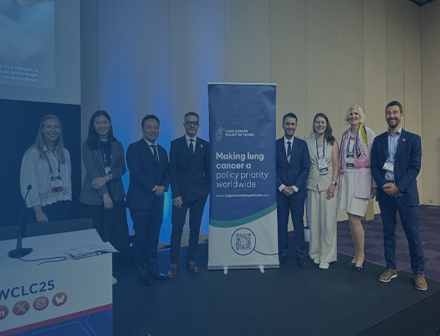Lung cancer is currently the most frequently diagnosed cancer and the leading cause of cancer-related deaths. In 2022, 2.48 million new cases were diagnosed, and 1.8 million people died from the disease; those numbers are predicted to increase to 4.62 million new cases and 3.55 million deaths per year by 2050. Five-year survival rates are as low as 10% in many countries, underscoring the urgent need for action.
Despite these compelling data, and the devastating effect of the disease on people’s lives, progress in policy has been slow. Even interventions that may change this picture – including prevention via tobacco control and earlier detection achieved through screening – continue to be implemented slowly.
But there is cause for hope. Fortunately, lung cancer continues to be firmly on the global health policy agenda. And as a Network, we strongly welcome this enhanced focus.
What has been happening in lung cancer policy?
This year saw a marked shift in global policy, thanks in large part to the efforts of researchers and advocates around the world. We saw the adoption of a resolution on integrated lung health, including lung cancer, at this year’s World Health Assembly.
Read our response to the lung health resolution
In wider lung cancer policy, a consensus statement on lung cancer, Bridging the Gap in the Diagnosis and Management of Lung Cancer, has helped solidify policy priorities. The statement was ratified by faculty and participants at the International Lung Cancer Network’s 2023 meeting, and has since been presented at several cancer-related conferences. The Asia Pacific Coalition Against Lung Cancer and ASPIRE for Lung Cancer successfully tailored the consensus into concrete recommendations and action points that reflect the region’s diverse populations, health systems and economies. Next year, we look forward to the International Agency for Research on Cancer’s anticipated Handbook on Lung Cancer Screening.
We must not forget that, alongside these developments, there are many local, regional and global activities promoting change and progress in lung cancer. And the Lung Cancer Policy Network is delighted that our evidence-informed and consensus-driven recommendations have contributed to this change.
What action is needed to build on the lung health resolution?
Particularly since the adoption of the lung health resolution, many are asking what’s next.
It is hoped that the resolution will provide a focal point for action and unlock funding from a range of sources. There are actions we can take, which build on previous work across the lung cancer community. They include:
- utilising the commitments in the lung health resolution and other policy documents to build consensus on lung cancer targets and measures, and building mechanisms for tracking progress against these goals
- conducting research to fill data gaps at the local, regional and global levels to continue to build a nuanced understanding of lung cancer risk and epidemiology
- ensuring that the disease is fully integrated into cancer control, including specifying lung cancer prevention and early detection in National Cancer Control Plans, accompanied by funding for implementation
- collaborating with other respiratory organisations and expert groups to create action plans against shared risk factors for lung conditions, and embedding prevention in these plans
- generating localised cost-effectiveness analyses for the interventions in the resolution to drive specific policy commitments; this is already taking place for low-dose computed tomography screening.
Looking ahead, it is important not to lose sight of the resolution, nor to view it as a moment in time. Sustained uptake of policy into practice will be needed with a long-term view to deliver real improvements for people at risk of, and living with, lung cancer.
How can advocates harness these policies to drive progress?
Any policy statements or commitments – particularly those that are broad and set at a large, even global, scale – must serve as a catalyst for action. The lung health resolution can act as a starting point for policy discussions in places where lung cancer is minimally included in health policy and planning.
An initial action for advocates is to use policy recommendations and commitments to assess gaps in local policy; this acts as an entry point or next step for discussions. Another key early action is to review recommendations and tailor them to local contexts to generate specific policy asks.
For advocates, building alliances with other experts, cancer groups, and groups working on lung health conditions – including chronic obstructive pulmonary disorder, tuberculosis and asthma – can uncover shared challenges and opportunities. These alliances help advance comprehensive policy asks that address a range of conditions with shared risk factors.
We will continue to work with our members and the wider lung cancer and lung health community to ensure that these commitments translate into concrete actions that transform the lives of people affected by lung cancer.
Recent news
Blog

Insights from WCLC 2025
At the World Conference on Lung Cancer in Barcelona, the Network hosted a very well-attended panel discussion focusing on the latest developments in lung cancer policy.
Case study

The screening programme for lung cancer in the Canadian province of British Columbia
We explore how a regional screening programme has been established throughout British Columbia.
News

Event to address lung cancer screening implementation in Central and Eastern Europe
On 16 September, the Network and the Croatian National Lung Cancer Screening Program will be hosting an in-person event.
